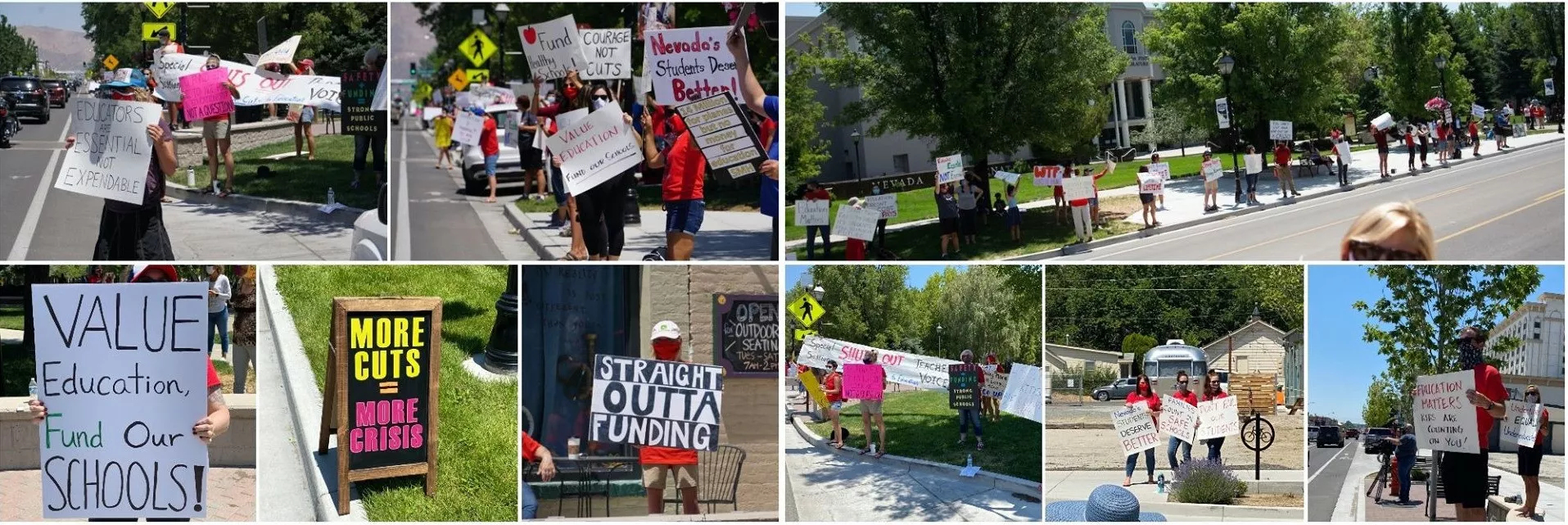Public School Funding

COVID-19 AND SCHOOL FUNDING: TWO CRISES COLLIDE
At the end of the 2019-20 fiscal year, the Governor and lawmakers had to close an $812 Million budget shortfall as the result of the decrease in revenues from the COVID-19 pandemic. Included in that budget shortfall was a $265 million shortfall in local revenue to the Distributive School Account (DSA). While the FY21 impact has yet to be determined, projections by Applied Analysis and others have estimated the shortfall at around $1 billion. The budget impact of COVID-19 is likely to last for years, impacting budget deliberations for next biennium. As such, Nevada is facing the most severe budget crisis in its history.
Prior to the COVID-19 pandemic, Nevada’s neighborhood public schools were already chronically under-funded with the most crowded classrooms in the country. As we reopen our schools, districts will have new expenses to implement state recommended health and safety guidelines. Per the American Association of School Superintendents, a school district with just 3659 students will incur an additional cost of $1,778,139. That number does not include major costs such as purchasing new school buses, physical modification to school building, or the cost of hiring new staff to significantly lower class size. We know the additional cost to safely reopen Nevada’s larger school districts will be substantial. As such, cuts to public education will compromise the ability to safely reopen, jeopardizing the safety of our kids, educators, and community.
Public education is the great equalizer, and Nevada made significant efforts in recent years to increase education equity. Unfortunately, the move to distance learning heightened inequities, especially for students with individual education plans, English learners, and at-risk students. There is no replacing in-person/one-on-one teacher-student instruction, especially with shortcomings of distance learning in reaching all students. Nevada needs to keep focused on improving education equity, which means continued investment in special education and models that work for English learners and at-risk students, like Zoom and Victory schools. Meanwhile, during a pandemic that has resulted in such disruption, the successful reopening of our public schools must include meeting the social and emotional needs of our students and educators.
The State’s approach to revenue in the past was never sufficient, and it certainly will not be moving forward in a post-COVID-19 world. Further defunding public education without a plan for new revenue is not an acceptable answer. As such, the Nevada State Education Association is calling on any budget balancing plan, for this biennium or next, to include at least a dollar of new revenue for any dollar cut from public education, a shared sacrifice.
The current economic crisis has already impacted nine-month, ten-month, and eleven-month education employees not eligible to receive unemployment benefits during the summer months. Under normal circumstances, most ESPs have summer employment opportunities. This is especially important for those who make less than a living wage during their working months. Unfortunately, with the COVID-19 pandemic, job opportunities are severely limited
To address these concerns, NSEA SUPPORTS:
- At least one dollar of new state revenue for every dollar cut from public education.
- Access to unemployment benefits for 9 to 11-month education support professionals.
- A renewed focus on the social and emotional needs of our students and educators.
- Maintenance of Nevada’s successful education equity programs, including Zoom and Victory Schools
SCHOOL FINANCE, THE CONTINUING CRISIS
Before COVID-19, education funding across the nation was already in crisis. From West Virginia to Oklahoma, Kentucky to Arizona, teachers and other educators took to the streets and their state houses to demand better pay and school funding under the banner RED FOR ED. During the last legislative session in February and again in May, hundreds of educators from across Nevada rallied in Carson City to draw attention to chronic underfunding of public education. Despite many efforts to address under-funding, Nevada continued to rank near the bottom of states in most metrics. In the 2020 Quality Counts report from Education Week, Nevada ranked 47th in School Finance and 50th in their overall “Chance for Success” index.
NSEA has been the loudest, most consistent voice in Carson City for increased school funding over the last several legislative sessions.
While some legislators worked to find the resources necessary to fund a modest educator raise this past year, others worked behind closed doors and without stakeholder input to design a new funding plan riddled with major problems. SB543 was passed in the final moments of the legislative session over NSEA’s serious objections. NSEA has consistently outlined our serious policy concerns, including no new revenue for schools, a budget “freeze and squeeze” of most Nevada school districts, watering down of Zoom and Victory Schools, a multimillion-dollar charter school giveaway, anti-union end fund balance provisions, exclusion of educator voice on the Commission on School Funding, and a fundamentally flawed legislative process.
To address these concerns, NSEA SUPPORTS:
- New, progressive revenue for schools.
- Stopping implementation of the new funding plan until after the COVID-19 economic crisis.
- Ensuring any new funding plan moving forward addresses the concerns of educators and community stakeholders.
Opposing Vouchers: Keep Public Money In Public Schools:
Voucher programs rob students of educational equity and opportunities. Scarce funding for public schools should not be siphoned off to unaccountable private and religious schools.
NSEA has been a consistent advocate for adequate public education funding and for keeping public funds in public schools. NSEA opposes school vouchers because they divert essential resources from public schools to private and religious schools, while offering no real "choice" for the overwhelming majority of students.
Teachers, parents, and the general public have long opposed private school tuition vouchers - especially when funds for vouchers compete with funds for overall improvements in America's public schools.
“Opportunity Scholarships” are really just back-door school vouchers. Over the last 3 years, not including the one-time expansion of the program last session, appropriations for “Opportunity Scholarships” have increased by more than 33%, while over the same period, per-pupil base funding for K-12 education has only increased by a little more than 4%. This is significantly less than the increased cost of doing business, which is a major reason we saw draconian budget cuts in school districts across the state immediately after last legislative session.
Instead of diverting funding to programs that pay for a limited number of students to go to private schools, Nevada has the responsibility to allocate sufficient funds to public schools, which are accessible to every Nevada student.
NSEA and its affiliates have been leaders in the fight to improve public schools- and oppose alternatives that divert attention, energy, and resources from efforts to reduce class size, enhance teacher quality, and provide every student with books, computers, and safe and orderly schools.
In the 80th Legislative Session, through SB551, NSEA and its partners were able to remove all ESA/Voucher language from the Nevada Revised Statute. Through AB458, we were able to begin a wind-down of the Opportunity Scholarship Program as well. These were huge victories for public school advocates.
Early Childhood Education
High-quality early childhood education is one of the best investments we can make. Comprehensive early childhood programs should be widely available and affordable for children from birth to age five–particularly for those from low-income families.
School Modernization
Far too much learning and teaching is happening in schools that pose health and safety risks to students and staff. Twenty-first-century learning requires 21st-century tools, classrooms, and schools.
Special Education
NSEA and NEA advocate for the fulfillment of a federal funding promise to ensure children with disabilities can access a free, quality education.
Access to a free, quality education is the key to the uniquely American promise of equal opportunity for all. This promise was formally extended to children with disabilities with the passage in 1975 of landmark federal legislation known as the Individuals with Disabilities Education Act (IDEA). That promise–worthy and just–remains unfulfilled.
KEY FACTS ABOUT FUNDING IDEA
- Public schools across the country today provide special education services to more than 7 million youngsters–14% of public school students.
- The federal law has always included a commitment to pay 40 percent of the average per student cost for every special education student. In the 2019 fiscal year, the federal government provided less than half of the full funding level for states.¹
- Since 2009, the annual cost shift from the federal government to the states has averaged about $19.5 billion.
- In the school year 2017-18, the federal appropriation was $21.5 billion less than full funding, which states and districts had to cover.
- This shortfall creates a burden on local communities and denies full opportunity to all students–with and without disabilities.
You can read more about the federal efforts being made by clicking here.
The Pupil Centered Funding Plan (Senate Bill 543)
While there are numerous issues with the new funding plan (which you can read more about here), the primary issue at this point is this is a funding plan with no funding attached. Given the chronic underfunding of public education in Nevada, any new funding model will fail without new and additional revenue.
In February and again in May of 2019, hundreds of educators from across Nevada rallied in Carson City under the banner of Red for Ed to draw attention to the chronic underfunding of public education. Despite many efforts to address under-funding, Nevada continues to rank near the bottom of states in most metrics. In the 2019 Quality Counts report from Education Week, Nevada ranked 47th in per-pupil funding and dead last in the overall “Chance for Success” report card.
After a 2019 Legislative Session with “historic” appropriations of education funding, school districts across the state continue to struggle with budget cuts. While NSEA’s bargaining units were able to negotiate raises for educators in most districts, some districts have balked, saying they can’t afford the raises. This has left thousands of educators frozen while CPI increased by 2.6% over the last 12 months. Meanwhile, most districts have warned of freezes or cuts in future years. An analysis released earlier this week from Educate Nevada Now shows most districts across the state with even less base funding from the state than last year. The ENN analysis correctly points out that base funding will increase by even less next year, leaving our schools further behind. Unless bold action is taken to raise significant new revenue, Nevada schools will remain chronically underfunded.
While NSEA believes the school funding plan should be updated to reflect the changing needs of Nevada, it would be completely irresponsible to implement this radical shift during these already turbulent times.

Until funding of public schools - all of them - is made a priority, we will continue to be at the top of the bad lists, and at the bottom of the good lists.